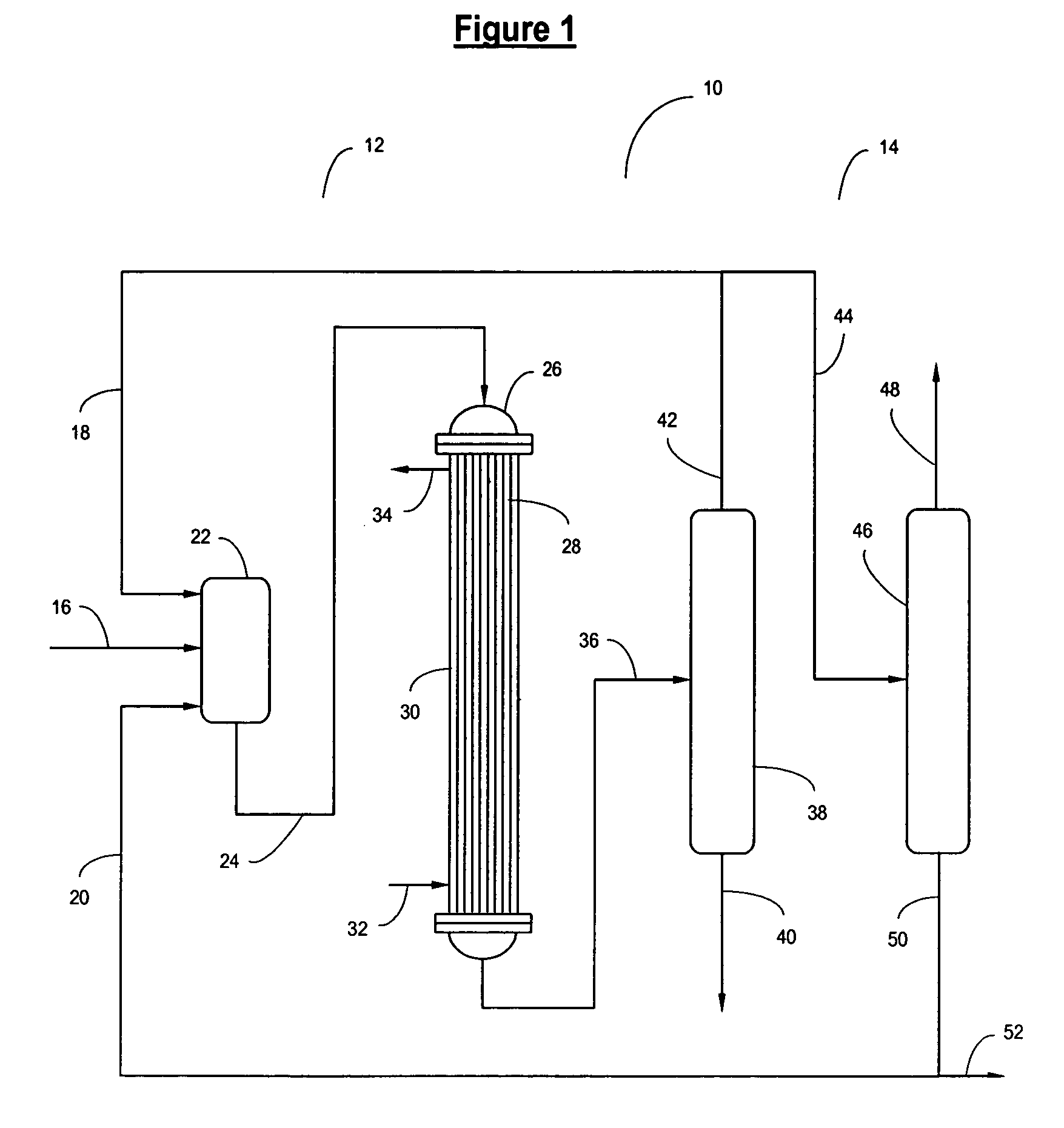Olefin Oligomerization
a technology of oligomerization and oligomerization, which is applied in the direction of hydrocarbon purification/separation, chemical/physical processes, and combustion gas purification/modification, etc., can solve the problems of additional components, complicated subsequent separation efforts, and more expensive and complicated fired heaters
- Summary
- Abstract
- Description
- Claims
- Application Information
AI Technical Summary
Benefits of technology
Problems solved by technology
Method used
Image
Examples
example 1
[0088] Olefinic feedstock and recycle materials were prepared as shown in Table 1 and were oligomerized over a catalyst comprising 65 wt % of 0.02 to 0.05 micron crystals of ZSM-5 having a SiO2 / Al2O3 molar ratio of 50:1, and 35 wt % of an alumina binder. The catalyst was in the form of 1 / 16 inch extrudates and about 90 cc of catalyst was blended with about 202 cc of inert, silicon carbide beads to reduce the heat generation per unit volume of reaction and placed in the reaction bed of a tubular reactor equipped with a heat management system that allowed the oligomerization reaction to proceed under near isothermal conditions.
TABLE 1Charge ACharge BFeedRecycleFeedRecycleWt. %49.5250.4841.8458.16ProportionComp. Wt. %11.0211.39Ethane0.000.000.000.00Ethylene0.000.000.000.00Propane0.000.000.010.00Propene0.000.000.000.00iso-butane7.240.100.990.02n-butane0.080.0011.610.03t-butene-20.000.1027.170.03butene-172.280.0016.310.00iso-butene2.880.002.650.01c-butene-20.010.0020.140.00iso-pentane0...
example 2
[0090] The same apparatus and procedure as Example 1 was utilized for a second, extended experimental run with a fresh batch of catalyst and another set of charge compositions as shown in Table 3. The olefinic feedstocks shown in Table 3 were produced by reacting methanol over a SAPO-34 catalyst generally according to the method of U.S. Pat. 6,673,978, with separation of the methanol reaction products to provide a C4+ olefin composition. Over 90 wt % of the olefins in each feed composition were normal in atomic configuration, and the feed composition further contained about 1000 wppm oxygenates, such as methanol and acetone (not shown in Table 3), and 1000 ppm dienes. Some minor adjustments of some components in the feed compositions were made by additions of reagent grade materials to test certain aspects of the operation.
[0091] The olefinic recycle compositions shown in Table 3 were produced by taking accumulated batches of the reaction products from the first and this second exp...
example 3
[0093] Several batches of distillate materials were produced from the fractionation of various batches of reactor product obtained in the first and second experimental runs. The carbon number distribution of those distillate material batches, via the Linear Paraffin GC method, are provided in Table 5. Distillates 1 and 2 in Table 5 were obtained from fractionation operations using the aggregate reactor product from the first experimental run, while Distillate 3 was obtained from fractionation operations of the aggregate reactor product from Charges C, D, and E of the second experimental run. All of the distillate materials contain all of the C11+ and almost all of the C10 material present from the reaction products, i.e., no separation of any components heavier than C11 was conducted on the reactor product in obtaining the distillate materials. As obtained directly from the reactor product via the fractionation tower, all the distillate materials are over 90 wt % non-normal olefin, ...
PUM
| Property | Measurement | Unit |
|---|---|---|
| Temperature | aaaaa | aaaaa |
| Temperature | aaaaa | aaaaa |
| Temperature | aaaaa | aaaaa |
Abstract
Description
Claims
Application Information
 Login to View More
Login to View More - R&D
- Intellectual Property
- Life Sciences
- Materials
- Tech Scout
- Unparalleled Data Quality
- Higher Quality Content
- 60% Fewer Hallucinations
Browse by: Latest US Patents, China's latest patents, Technical Efficacy Thesaurus, Application Domain, Technology Topic, Popular Technical Reports.
© 2025 PatSnap. All rights reserved.Legal|Privacy policy|Modern Slavery Act Transparency Statement|Sitemap|About US| Contact US: help@patsnap.com


